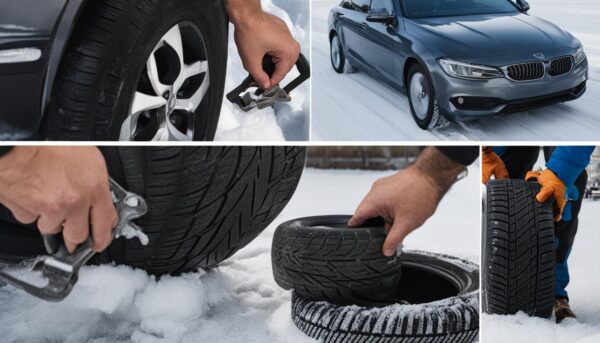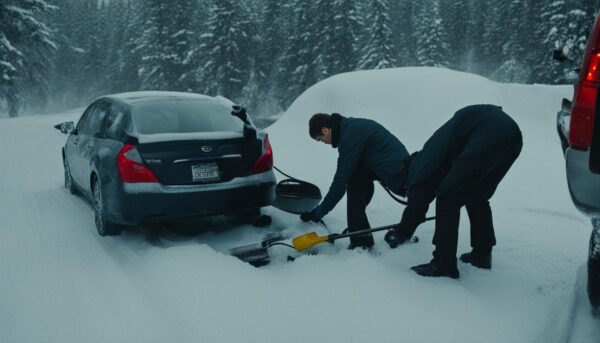Last Updated on 1 week
Mastering the Art of Installing Snow Tires with Ease
As winter weather sets in, snow tires become essential to maintain traction and control on slippery roads. Installing winter tires is crucial to winter driving safety, ensuring your vehicle performs optimally in snowy and icy conditions. This comprehensive guide will provide detailed instructions on safely and effectively installing winter tires and helpful insights into selecting the best snow tires, proper maintenance, and the potential use of snow chains.
Key Takeaways
- Snow tire installation is important for driving safety during winter months.
- Selecting the proper snow tires for your vehicle and driving conditions is crucial for optimal performance.
- Proper installation techniques and tools are necessary for a successful tire change.
- Maintenance of your winter tires ensures their longevity and maximum efficacy.
- Snow chains can provide additional traction in extreme winter conditions when needed.
Understanding the Critical Role of Snow Tires in Winter Safety
Installing snow tires is a pivotal safety measure that provides essential traction and control for navigating harsh winter conditions. These tires are an annual task and an indispensable component of vehicular safety. The proper fitment of snow tires on a vehicle allows for enhanced performance during the winter months and peace of mind while driving on snow-covered and icy roads.
Snow tires are designed to improve winter driving safety, as they are constructed with unique rubber compounds that maintain flexibility and grip even in freezing temperatures. Additionally, the specialized tread patterns of these tires facilitate improved tire traction on snow and ice, ensuring optimal vehicle stability, handling, and braking performance during winter months.
“Snow tires can reduce the risk of winter-related accidents by up to 38%, making them an essential investment for safe driving in low temperatures and challenging road conditions.”
To further emphasize the importance of snow tires, let’s explore some of the key advantages:
- Improved traction on slippery surfaces
- Enhanced braking performance in snowy and icy conditions
- Better handling and overall stability of the vehicle
- Reduced risk of accidents during winter months
| Feature | Snow Tires | All-Season Tires |
|---|---|---|
| Performance in Snowy Conditions | Excellent | Fair to Moderate |
| Performance in Icy Conditions | Very Good | Poor to Fair |
| Handling Stability in Cold Weather | Superior | Average |
| Braking Performance in Frosty Roads | Highly Effective | Less Effective |
In conclusion, snow tires are a crucial investment for those living in regions with cold winters, as they offer superior traction, safety, and performance in adverse road conditions. By understanding the critical role of snow tires in winter safety, drivers can ensure their vehicles are adequately prepared for the challenges ahead and reduce the risk of winter-related accidents.
Preparing for Snow Tire Installation: Tools and Safety Precautions
Before embarking on snow tire installation, gathering essential tools and keeping safety in mind is paramount.
Gathering the Necessary Equipment for a Smooth Installation
Having the right snow tire tools at your disposal ensures a successful and efficient installation. The key tools required are:
- Tire Jack: To safely lift your vehicle, ensure you have the correct type according to your vehicle’s weight.
- Lug Wrench: Utilized for loosening and tightening the lug nuts on your tires.
- Torque Wrench: Necessary for securing lug nuts to the manufacturer’s specifications.
- Tire Safety Equipment: Wheel chocks or bricks to prevent unexpected movement during installation.
Ensuring Safety with Proper Pre-installation Preparations
Creating a secure environment before snow tire installation is crucial. Follow these safety tips to foster a safe installation process:
- Select a flat and stable area for installation, avoiding icy or sloped surfaces that may cause hazards.
- Use wheel chocks or bricks in front of and behind the tires to prevent the vehicle from rolling.
- Activate the parking brake for added security.
- Consult the vehicle’s manual for proper car jacking points to ensure a secure lift.
Adhering to these tire-changing safety guidelines will prepare you for a smooth and successful snow tire installation process.
Selecting the Right Snow Tires: What to Look For
When selecting snow tires, there are several factors to consider beyond the tire size. To find the perfect snow tire, you need to understand your specific winter driving conditions, such as the severity of the snow or icy terrain. Knowing your vehicle’s tire size and selecting the correct tire will deliver the best performance and prevent any potential damage to your tires and vehicle alignment.
Choosing the right snow tires can significantly impact your winter driving experience and safety.
Winter Tire Features: What to Watch For
- Tread Pattern Design: Winter tires should have a deep, aggressive tread pattern to provide maximum grip on snow and ice.
- Flexible Rubber Compound: Look for tires that use a flexible rubber compound to maintain grip at lower temperatures.
- Siping: Tires with numerous sipes can offer improved traction on icy surfaces.
- Studdable vs. Non-Studdable: If you frequently drive on icy roads, consider studdable winter tires for added traction.
Snow Tire Specifications to Check
- Load Rating: Ensure the tire can safely support the weight of your vehicle.
- Speed Rating: Choose a tire with a speed rating that matches or exceeds your vehicle’s requirements.
- Size: Check your vehicle’s owner’s manual or the driver’s door jam information for the recommended tire size.
- Compatibility: Verify that your chosen tire is compatible with your vehicle’s rim type, such as steel or alloy wheels.
You may be tempted to save money by going for a cheaper brand or buying used snow tires when it comes to tire purchasing. However, investing in a high-quality and reputable brand will offer better long-term value, safety, and performance.
| Reputable Snow Tire Brands | Product Line |
|---|---|
| Bridgestone | Blizzak WS80, DM-V2 |
| Michelin | X-Ice Xi3, Latitude X-Ice Xi2 |
| Continental | WinterContact SI, VikingContact 7 |
| Nokian | Hakkapeliitta R3, Hakkapeliitta 9 |
Remember to consider the type and frequency of winter driving you’ll be doing, and choose a tire that best matches your needs. Researching and understanding the various winter tire features and snow tire specifications will ensure you make the best choice for your vehicle, driving habits, and local climate.
The Step-by-Step Guide to Installing Your Snow Tires

Installing snow tires is critical to ensuring maximum safety and performance throughout winter. Following this comprehensive snow tire installation guide, you can confidently and efficiently install your snow tires without hassle. Below is a detailed tire installation step-by-step guide covering everything you need to know about winter tire mounting.
- Gather the necessary tools: To start your snow tire installation process, ensure you have all the needed equipment, including a jack, lug wrench, and torque wrench.
- Select a safe location: Choose a flat, stable surface for tire installation and avoid icy or sloped areas. Use wheel chocks or bricks to prevent the vehicle from rolling while installing.
- Loosen the lug nuts: Before jacking up your vehicle, slightly loosen the lug nuts on your tires using the lug wrench. This will make it easier to remove the tires once the car is elevated.
- Jack up the vehicle: Find the designated jacking points in your vehicle’s manual, then carefully lift the car using the jack.
- Remove current tires: Once the vehicle is safely and sturdily elevated, remove the lug nuts and your existing tires.
- Mount snow tires: Mount your snow tires onto the vehicle by aligning the bolt holes on the tire with the ones on the wheel hub. Slide the tire onto the seat and hand-tighten the lug nuts.
- Lower the vehicle: Carefully lower your vehicle back onto the ground using the jack, ensuring the tires are securely in place.
- Tighten lug nuts in a star pattern: Tighten the lug nuts using a torque wrench, following a star pattern to ensure even tightening. This helps to maintain proper wheel alignment and balance.
Once you have completed all tire installation steps, driving for a short distance and double-checking the lug nuts’ tightness is crucial. This ensures your snow tires remain secure and provide optimal traction and control during winter drives.
Remember: Recheck the tightness of the lug nuts after driving a short distance to ensure their security.
| Step | Description |
|---|---|
| 1 | Gather the necessary tools |
| 2 | Select a safe location |
| 3 | Loosen the lug nuts |
| 4 | Jack up the vehicle |
| 5 | Remove current tires |
| 6 | Mount snow tires |
| 7 | Lower the vehicle |
| 8 | Tighten lug nuts in a star pattern |
Following this snow tire installation guide and understanding each tire installation step in detail can ensure a safe and effective winter tire mounting experience. Proper installation is crucial for maintaining your vehicle’s performance, traction, and safety during the challenging winter months.
Professional vs. DIY Snow Tire Installation: What’s Best for You?
While there’s a certain satisfaction in successfully installing snow tires yourself, weighing the pros and cons of professional snow tire installation and DIY tire installation is essential. Every driver must consider aspects such as time constraints, necessary tools, and confidence in their abilities before deciding on the best option.
Assessing the Benefits of Professional Tire Installation Services
Opting for professional mechanic tire services can save you time, hassle, and potential safety risks. A qualified and experienced professional will have the expertise and specialized tools to ensure proper fitment and balance of the snow tires for optimal performance and safety.
“With a professional snow tire installation, you can trust that the job will be done right without the burden of buying or finding the necessary equipment.”
Here’s a comparison of the advantages and disadvantages of professional tire installation services versus DIY snow tire installation:
| Professional Snow Tire Installation | DIY Tire Installation |
|---|---|
| Technicians possess specialized tools and equipment for efficient installation. | It may require an outlay on tools and equipment if not readily available |
| Quick and hassle-free service | Potentially time-consuming, particularly if inexperienced |
| Technicians can carry out tire safety checks and offer guidance on maintenance | Requires some familiarity with checklists and inspection best practices |
| Adjusted and balanced tires for optimal vehicle handling | Requires knowledge and experience to ensure proper tire balancing and alignment |
| Potentially higher cost for convenience | Cost savings if all tools and equipment are readily available |
For drivers who lack the necessary tools and experience or prefer the convenience of a professional service, the benefits of professional snow tire installation often outweigh the additional costs. Ultimately, you must assess your confidence, experience, and resources when deciding whether to tackle the task or entrust the job to a specialized mechanic.
Maintaining Your Snow Tires for Optimal Performance and Longevity

Regular snow tire maintenance is essential for ensuring safe and efficient winter driving. By performing periodic checks for wear, monitoring tire tread inspection, and maintaining proper tire pressure, you can extend the life of your snow tires and guarantee optimal performance throughout the season. The following steps will guide you through a comprehensive winter tire care regimen.
- Check for visible wear: Inspect the rubber surface of your snow tires for any signs of damage, cuts, or punctures that could lead to a blowout or reduced traction in snowy conditions.
- Measure tread depth: Regularly measuring the tire tread depth using a tire tread depth gauge helps ensure that your snow tires continue to offer adequate traction and grip on the road surface.
- Ensure proper tire pressure: In cold temperatures, tire pressure can drop, affecting handling and traction. Check and adjust your tire pressure according to the manufacturer’s specifications at least once a month.
- Monitor alignment and balance: Ensure your tires are correctly aligned and balanced to prevent uneven wear and potential damage to the suspension system.
- Rotate tires: Rotating your snow tires about every 5,000 miles can help extend their lifespan by promoting even wear across all tires.
“Proper snow tire maintenance is crucial in keeping your winter tires in optimal condition for safe driving on snowy and icy roads.”
Staying vigilant about your winter tire care routine will prolong your tire’s life and contribute to improved performance, ensuring a safer winter driving experience. Regular maintenance checks and timely interventions can make all the difference in your tires’ performance and longevity.
| Maintenance Task | Frequency | Purpose |
|---|---|---|
| Check for visible wear | Monthly | Identify potential damage and reduce the risk of blowouts |
| Measure tread depth | Monthly | Ensure adequate traction and grip on road surfaces |
| Check and adjust tire pressure | Monthly | Improve handling and traction in cold temperatures |
| Monitor alignment and balance | At tire rotation | Prevent uneven wear and potential suspension damage |
| Rotate snow tires | Every 5,000 miles | Promote even wear and extend tire lifespan |
Do’s and Don’ts: Snow Tire Installation Mistakes to Avoid
Snow tire installation is critical to maintaining vehicle safety and optimal handling during winter months. It is crucial to avoid potential snow tire installation errors or mistakes to ensure the performance and longevity of your snow tires and your safety on the road. In this section, we will look closer at the common pitfalls in the installation process and discuss the importance of proper tire pressure and alignment.
Common Pitfalls in the Installation Process
Several tire installation mistakes may lead to suboptimal performance and create safety hazards. Be sure to avoid the following errors:
- Failing to select the correct tire for the vehicle’s specifications: Pay attention to your vehicle’s manual and choose the appropriate winter tire fitment according to the recommendations provided.
- Improperly tightening lug nuts: Use a torque wrench to ensure lug nuts are tightened evenly and with the correct force. An incorrect or inconsistent lug nut tightening procedure could cause the wheel to come off during driving, leading to an accident.
- Overlooking the manual’s fitment points: Consult your vehicle’s owner manual for the specific fitment points to follow when jacking up the car, as disregarding them may lead to damage or misalignment.
- Not testing the tires after installation: Make sure to test drive your vehicle after installing the snow tires and verify the proper mounting of the tire on the wheel and the functioning and adjustments of all the components involved.
Ensuring Proper Tire Pressure and Alignment
After installing your snow tires, always double-check for correct tire pressure and alignment:
- Tire Pressure: Refer to your vehicle’s manual for the recommended tire pressure and make sure your snow tires have the correct inflation levels. Over- or under-inflated tires lead to uneven wear, compromised traction, and potential safety hazards. Don’t forget to check your tire pressure regularly throughout the winter season.
- Tire Alignment: Proper alignment is crucial for your snow tires’ optimal performance and safety. Poor alignment may result in uneven tire wear, adversely affecting traction and handling. Have your alignment checked and adjusted, if necessary, by a professional technician.
In conclusion, avoiding snow tire installation mistakes is essential to maximizing snow tire safety and vehicle handling during winter. By diligently selecting the proper winter tire fitment, adhering to correct lug nut tightening procedures, and maintaining tire pressure and alignment, you will help keep yourself and others safe on the road throughout the snowy season.
When to Switch: Timing Your Snow Tire Installation for Maximum Efficacy
Maximizing the effectiveness of snow tires requires proper timing for their installation. Ideally, drivers should switch to snow tires before the onset of winter weather, allowing their vehicles to be equipped to handle the challenges of winter driving from the start of the season.
As a general guideline, installing snow tires when temperatures consistently drop below 45°F (7°C) is best. By ensuring this snow tire switch timing, drivers can avoid the sudden complications of icy roads or heavy snowfall with their vehicles already acclimated to the winter environment.
Here are some key considerations for determining the best time to install snow tires:
- Monitor weather forecasts and plan the tire installation accordingly. Pay attention to sudden drops in temperature and the onset of snowfall or icy conditions.
- Take note of local seasonal patterns and trends, enabling you to anticipate your region’s winter tire efficacy requirements.
- Schedule the seasonal tire change during the fall months, ideally before heavy snow and freezing temperatures arrive.
- Ensure the tires are installed promptly for better traction and control during the early stages of winter.
“The best time to install snow tires is before the onset of winter weather, providing your vehicle with optimal leverage against the challenges of winter driving.”
In conclusion, the best time to install snow tires is when temperatures consistently drop below 45°F (7°C). Proper timing allows drivers to be prepared for the challenges of winter driving conditions, ensuring maximum efficacy of the snow tires throughout the season.
Enhancing Winter Traction: The Role of Tire Chains with Snow Tires
Snow tires significantly benefit driving in winter conditions, particularly traction and safety. However, in some extreme situations, specifically on icy terrains or heavy snowfall, utilizing snow chains can offer winter traction enhancement beyond what snow tires alone can provide. This additional measure ensures a safer and more secure driving experience in treacherous conditions.
Deciding If Snow Chains Are Necessary for Your Winter Driving
The decision to employ snow chains depends on factors such as the severity of weather conditions, the type of road surfaces you encounter, and your driving requirements. Areas that frequently experience heavy snowfall or icy road conditions may necessitate the installation of snow chains. Additionally, snow chains are mandatory in some locations during specific periods to maintain road safety for all drivers, so check local regulations before traveling in extreme winter conditions.
If you live in an area with occasional snowfall or experience mild winter weather conditions, snow chains may not be necessary on a regular basis. However, it is still a good idea to have a set in your vehicle in case of sudden weather changes or if you plan on traveling to areas prone to severe winter conditions.
Choosing the proper type and fit for your vehicle and snow tires is crucial when using snow chains. Improper fit or incompatible chains can cause damage, reducing their traction and safety benefits. To ensure a correct fit, consult your vehicle’s owner’s manual or speak with a professional tire expert. Some popular snow chain brands include Thule (also known as König), Pewag, and Rud, and their products cater to various tire sizes and vehicle types.
| Chain Type | Characteristics | Benefits |
|---|---|---|
| X-Style Ladder Chains | Constructed in a cross or ladder design and available in several materials, such as alloy, steel, and manganese. | Better traction on ice, effective braking, and comfortable ride quality. |
| Diamond Pattern Chains | Constructed in a diamond or web design, it covers more of the tire’s surface and provides optimal traction. | Increased grip on slippery surfaces, smooth ride, and easier installation than ladder chains. |
| Automatic Tightening Chains | Tensor or ratchet system equipped chains that automatically tighten on the tire during driving. | Reduced manual adjustments and user-friendly installation, ideal for novice users. |
- Select the correct type of snow chains based on your vehicle and driving requirements.
- Ensure proper fit on your snow tires to maximize traction and prevent potential damage.
- Follow the manufacturer’s instructions for snow chain installation and removal.
- Practice installing snow chains in a safe and controlled environment before attempting to do so in real winter conditions.
- Always drive at reduced speeds, usually below 30 mph, when snow chains are fitted on your tires.
- Regularly inspect the chains for damage and maintain them according to the manufacturer’s instructions.
In conclusion, snow chains can be invaluable in enhancing winter traction, adding extra safety and security to your snow tire-equipped vehicle. Remember to evaluate your driving needs, research the appropriate chain type, and ensure a proper fit for the best results. Doing so allows you to confidently traverse the challenging winter roads with additional winter driving safety measures.
Storing Off-Season Tires: Tips for Preserving Your All-Season and Summer Tires
As you switch to winter tires, properly caring for your all-season or summer tires is crucial to ensure their longevity and performance. By following appropriate off-season tire care practices and storage techniques, you can protect your tires from damage and ensure they remain in good condition for their respective seasons.
Proper summer tire storage begins with selecting an appropriate location. Choose a cool, dry place, ideally away from direct sunlight or sources of heat and moisture. A garage or a climate-controlled storage unit is an excellent option, providing the tires protection from environmental elements.
An important tip for all-season tire preservation is to store the tires in tire bags or wraps specifically designed for tire storage. These bags can help protect your tires from dirt, moisture, and UV damage.
Another crucial aspect of storing winter tires is maintaining their position during storage. There are various storage methods to consider, depending on the amount of space available and your personal preferences:
- Stack the tires horizontally, but limit the stack to four tires to prevent unnecessary stress.
- Store the tires vertically in a standing position if you have limited space.
- Hang the tires on wall-mounted hooks or racks specifically designed for tire storage.
Before storing the tires, clean them thoroughly, removing any dirt, debris, and brake dust that may have accumulated. A simple solution of mild soap and water works well for cleaning.
| Storage Method | Pros | Cons |
|---|---|---|
| Horizontal Stacking | Easy to stack; minimal storage space needed | It may cause stress on the lower tires if piled too high |
| Vertical Standing | Reduces stress on individual tires | Requires more floor space |
| Wall-Mounted Hooks/Rack | Maximizes floor space; alleviates tire stress | Requires wall space and installation of hooks/rack |
Following these tips and techniques for off-season tire care ensures that your all-season and summer tires are well-maintained and ready for use when the seasons change.
Conclusion
Snow tire installation is critical to winter driving safety and should be carefully scrutinized. By following the guidelines in this article, you’ll be preparing your vehicle for optimal performance during adverse weather conditions. Don’t forget the importance of being proactive when installing snow tires, as proper timing helps maximize their efficacy.
Always remember that vehicle safety depends on choosing the right snow tires, proper installation techniques, and regular tire maintenance. Ensuring appropriate tire pressure, tread depth, and alignment will maintain the integrity of your snow tires and extend their lifespan.
As a responsible driver, prioritizing winter driving readiness and adhering to the expert advice outlined in this guide can provide you peace of mind during the season. By taking all necessary steps in the snow tire installation process, you’ll contribute to a safer driving experience for yourself and others on the road. Stay safe out there and embrace the winter season with confidence in your vehicle’s performance.
FAQ
When should I switch to snow tires?
Ideally, snow tires should be installed before the onset of winter weather, typically when temperatures consistently drop below 45°F (7°C). Proper timing ensures the vehicle is equipped to handle the challenges of winter driving conditions from the start of the season.
What tools do I need for snow tire installation?
You will need a jack, lug, and torque wrench to install snow tires. These tools are essential for a successful tire change and ensure the installation process can be completed effectively and efficiently.
Are tire chains necessary for snow tires?
Tire chains can provide additional traction for snow tires in extreme winter conditions, specifically icy terrains or heavy snowfall. The choice to employ snow chains depends on the severity of the weather, road conditions encountered, and personal driving requirements.
What maintenance should be performed on snow tires?
Regular snow tire maintenance includes periodic wear checks, monitoring tread depth, and ensuring the tires remain properly inflated. This maintenance helps sustain tire performance and extends their lifespan, which is crucial for safety during winter driving.
Can I install snow tires myself, or should I seek professional help?
While snow tire installation can be a DIY task, there are advantages to professional installation, such as expertise in proper fitment and access to specialized tools. Mechanics can also verify tire pressure and offer guidance on maintaining your tires throughout the winter. If you lack confidence or necessary equipment, professional services may be advantageous.
How can I store off-season tires properly?
When snow tires are used, storing all-season or summer tires in a cool, dry place, ideally in tire bags, is important to protect them against environmental elements. Proper storage techniques can prolong the life of these tires, ensuring they remain in good condition for their respective seasons.










